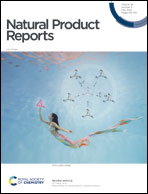Trends of antimalarial marine natural products: progresses, challenges and opportunities†
Abstract
Covering 1972 to 2021
Malaria remains a significant public health problem in some regions of the world. The great efforts to control malaria have been severely compromised due to the widespread resistance of Plasmodium falciparum to nearly all frontline drugs. Pursuit of novel molecules from the sea will potentially result in new interventions against malaria, which are urgently needed to combat the increase of resistance. Focusing on the strategy of the “Blue Drug Bank”, the molecules highlighted here can serve as an inspiration for future medicinal chemistry campaigns. This review covers the developments in the field of antimalarial marine lead compounds reported between 1972 and July 2021, and offers a comprehensive overview on their progresses and potentials. We selected 60 representative potential candidate molecules from 361 marine natural products, and highlighted their structure–activity relationships, molecular mechanisms of targets, and drug-like properties in order to assess their full potential to be developed. We summarized 107 clinically proven or potential antimalarial targets and their subcellular locations in the relevant target proteins, which linked the molecules to the target proteins at the subcellular level. Hence, it could be expected that natural products targeting different mechanisms may prove to be an effective strategy in antimalarial drug research and development in the future.



 Please wait while we load your content...
Please wait while we load your content...